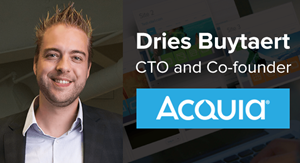Top Vendors Weigh In On Forrester WCM Wave 2017
By Venus Tamturk
January 30, 2017
Acquia, BloomReach, content management, Content Strategy, Episerver, Hippo CMS, SDL, sitecore, vendors, Web Content Management
As you may recall, hot on the heels of The Forrester Wave: Web Content Management Systems, Q1 2017 report, CMS-Connected reached out to Forrester’s Senior Analyst Mark Grannan to discuss the evolution of the web CMS landscape and the changing enterprise requirements. Armed with this comprehensive report and Mark Grannan’s splendid insight, we wanted to shine our light on the strongest six solutions featured in the Forrester’s Wave report, paired with their leadership’s exclusive comments to CMS-Connected.
Who Leads the Pack?
ACQUIA
Acquia, a Drupal-based open source content management system provider, has been recognized as the leader for strategy and vision in the report, for the first time ever. As we reported last year, the company has been aggressively beefing up its platform. Acquia Lift for instance, which is Acquia’s SaaS solution for creating personalized and contextual digital experiences, which has been enhanced with some powerful new capabilities:
-
A new card-based, intuitive UI with drag-and-drop content targeting
-
Merging anonymous and known visitor profiles
-
Enterprise CMS integration and content syndication from any source
-
Turnkey integration with Drupal 7 and Drupal 8
-
Real-time, adaptive segmentation
-
Behavioral targeting and A/B testing
In Forrester’s report, Acquia obtained the highest strategy score among all vendors. Additionally, they received the highest score in seven of the 25 criteria, according to their press release: component-based architecture, content localization, global and multisite management, vision, service partner program, developer program and product customer count.
CMS-Connected reached out to Dries Buytaert, Acquia CTO and co-founder, to inquire about the driving  factor behind being recognized as the leader for strategy and vision: “Since our founding Acquia has invested in the powerful combination of cloud and open source to deliver innovative, enterprise solutions for web content management using Drupal," he said and added: "It’s exciting to see that we were recognized as the leading vendor for strategy and vision, validating our commitment to the cloud, open source, and open APIs. I believe that Acquia’s solution provides our customers with the innovation model necessary to succeed in building and delivering ambitious digital experiences."
factor behind being recognized as the leader for strategy and vision: “Since our founding Acquia has invested in the powerful combination of cloud and open source to deliver innovative, enterprise solutions for web content management using Drupal," he said and added: "It’s exciting to see that we were recognized as the leading vendor for strategy and vision, validating our commitment to the cloud, open source, and open APIs. I believe that Acquia’s solution provides our customers with the innovation model necessary to succeed in building and delivering ambitious digital experiences."
The compelling combination of open source and cloud has been the main driving factor behind the vendor’s unprecedented growth. They were also named as a Leader in the Gartner’s most recent MQ report for WCM, after narrowing the gap on Sitecore and Adobe. As far as the strategy goes, Acquia focused on API-first delivery and secure cloud deployment. This winning strategy landed the vendor in the “Leaders” category, in both of the most respected reports in the industry.
Another important strength of the platform is that its components, such as Acquia Lift, share a common UI and open source heritage with Drupal today. If you would like to learn more about Acquia Lift and Acquia's future plans, I recommend watching this exclusive interview with Dries Buytaert, Co-founder and CTO at Acquia.
ADOBE
I think the most significant strength of Adobe’s evaluated platform, Adobe Experience Manager (AEM), is its strong integration with Adobe Creative Cloud and Adobe Marketing Cloud. In this way, the vendor has not only beefed up its cutting-edge digital experience platform, but has also wisely taken advantage of the high brand awareness of these offerings. In addition to this, the other remarkable strengths of the product are digital asset management (DAM), analytics, and targeting features powered by microservices and machine learning.
On the flip side, the platform's prognosis is not all rosy. Discerning users won't fail to notice the vendor’s pricing strategy and pricing structure. First off, Adobe’s pricing is relatively high, especially for the midmarket position its platform occupies. Businesses may naturally be reluctant when it comes to going all-in with the software, due to common concerns regarding ROI. A second weakness related to its pricing is the reported confusion between its "out of the box" and core WCM offerings. Nevertheless, the platform has been received quite well by the large enterprise market and is evolving with its cutting-edge technology.
EPISERVER
This year, Episerver, the Stockholm-based digital experience provider, made the cut and entered the leader category of Forrester’s Wave. In my opinion it is a fair decision, considering the vendor’s accelerating investment in cloud technology and recent acquisitions. In 2016, Episerver stepped up its game with marketing features such as personalization, optimization, and omnichannel campaign management. These enhancements were received very well in the market.
 CMS-Connected reached out to James Norwood, Executive Vice President Strategy, CMO at Episerver, to discuss the main reason behind Forrester’s valuable recognition: "We invested a great deal into our platform and partner network in 2016, so it's encouraging to see the industry recognize us as a leader in the WCM space. Our position in this Forrester Wave reflects our continuing growth and in particular North American traction, and that won't stop anytime soon. In 2017, we'll continue the progress we've made and work toward our vision of helping deliver continuous and consistent journey engagement for our customers, through individualized digital experiences that feature content at the core."
CMS-Connected reached out to James Norwood, Executive Vice President Strategy, CMO at Episerver, to discuss the main reason behind Forrester’s valuable recognition: "We invested a great deal into our platform and partner network in 2016, so it's encouraging to see the industry recognize us as a leader in the WCM space. Our position in this Forrester Wave reflects our continuing growth and in particular North American traction, and that won't stop anytime soon. In 2017, we'll continue the progress we've made and work toward our vision of helping deliver continuous and consistent journey engagement for our customers, through individualized digital experiences that feature content at the core."
As every rose has its thorn, Episerver’s service partner ecosystem in North America has been criticized in the both Gartner’s most recent Magic Quadrant for WCM report and Forrester’s Wave report. This situation has been an impediment against Episerver's appeal with large enterprises. Gartner had noted that competitors’ offerings often are recommended by implementation partners, even in some cases where Episerver would have been the best fit. Last October, I asked James Norwood what his opinions were surrounding this issue, and what Episerver’s plans are. In recognition of this issue, Episerver recently added six new resources in the USA – aimed solely at partner engagement, development, marketing, and sales support. A strategy of partner mindshare is key to success in WCM. Personally, I always consider weaknesses as areas of opportunity. Based on their likeminded approach, Episerver seems to have had a solid strategy in place to take advantage of that opportunity.
As CMS-Connected’s Principle Analyst Gary Eisenstein stated in his review, Episerver is worth a deep-dive if cloud is at the top of your mid-market WCM requirements; their Digital Experience Cloud is impressive, with a full stack wrapped up in a pay-as-you-go service model. Although there is a need for further enhancements to its PaaS offering and the Digital Experience Hub, Episerver CMS is a solid solution for the upper mid-market to lower enterprise market.
Strong Performers
HIPPO
2016 has treated Hippo very well. First, the vendor launched its PaaS offering, Hippo OnDemand, built on Amazon AWS and Docker technology. Hippo OnDemand offers the ability to set up and manage different environments from Development, to Test and User Acceptance, and finally Production. With that release, the vendor made improvements to its personalization engine, and added a native relevance store into its platform. Previously, it was integrating with a third-party tool for its relevance mode. Our contributing writer Barb Mosher Zinck asked the vendor how its support model works for Hippo onDemand. She discovered that they support the PaaS components as well as the Hippo platform itself, including performance aspects, hotfixes, security patches and so on. But when it comes to supporting the actual implementation specifics, support falls under a different model, which is typically provided by either Hippo Professional Services or the customer’s implementation partner. According to Forrester, despite some lagging underlying architectural components, Hippo leads with native, PaaS deployment.
In addition to the major release, Amsterdam-based Hippo was acquired by BloomReach, a California-based e- commerce personalization startup, in November 2016. The acquisition is expected to enable Bloomreach to apply its seven-year artificial intelligence and machine learning technology expertise to the web content management space. The biggest potential challenge that this newly combined company may face might be tackling more traditional, enterprise-type cases, due to both Hippo’s and BloomReach’s startup status.
commerce personalization startup, in November 2016. The acquisition is expected to enable Bloomreach to apply its seven-year artificial intelligence and machine learning technology expertise to the web content management space. The biggest potential challenge that this newly combined company may face might be tackling more traditional, enterprise-type cases, due to both Hippo’s and BloomReach’s startup status.
CMS-Connected reached out to Arjé Cahn, CTO Europe, BloomReach (Hippo) to inquire what their strong debut in the Forrester Wave indicates: “Hippo has always been a platform designed for developers and marketers alike, and our strong debut in the Forrester Wave reflects our commitment to supporting every part of the business. We scored top marks for our responsive and adaptive design, which gives marketers the relevance and personalization tools to create contextual content, and on our back-end extensibility, which gives developers the integration capabilities they need. Business gets more digital every day, and providing your entire team with the right tools to innovate is imperative to remaining competitive.”
SITECORE
Interestingly, though Forrester deposed Sitecore from the leader’s board due to their lack of a cloud strategy, Gartner named Sitecore as a “Leader”. The vendor won Gartner's accolades for "Completeness of Vision" in its latest report. Last year, Sitecore kicked off its annual user conference with the release of version 8.2 of its Experience Platform. One of the most important enhancements Sitecore made with XP 8.2 was the Experience Accelerator (XA); it offers over 80 pre-built components, and provides a drag and drop wireframing environment that enables non-techies to create pages quickly. Given that a number of prominent enhancements have been made across the platform, some have thought that the vendor added complexity, whereas others have found that the new release made the particular components, such as segmentation, easier to use. Nevertheless, the platform is not great when it comes to integrating with the third-party tools; addressing this should certainly be on the vendor’s agenda for upcoming enhancements.
If you are interested in hearing about the other enhancements, I highly recommend watching the video below, in which our Media Reporter, Laura Myers, elaborates on how Sitecore is single-handedly changing the digital marketing landscape. Heather MacFayden, VP at Falcon Software, also explains the new release from a usage perspective:
SDL
SDL, a provider of global content management and language translation software and services, has undergone a series of organizational changes. Additionally, the vendor combined 5 of their previous products to create the new SDL Web 8. From there, last November SDL announced two global solutions, a marketing solution, and the release of SDL Trados 2017, offering a solution for the adaptation, management, and delivery of global omnichannel content through the combination of content management and translation management technology. Hot on the heels of these announcements, I interviewed Peggy Chen, Chief Marketing Officer at SDL, to inquire about the challenges SDL specifically wanted to address with these new, integrated offerings. She told me that with the new solutions, which include integrated translation capabilities and a content management system available in the cloud, users can get local and global website campaigns up and running very quickly across every channel.
 CMS-Connected reached out to Arjen van den Akker, Product Marketing Director at SDL, to discuss SDL being recognized by Forrester as a Strong Performer: “Enterprises are looking to rapidly scale globally, in an efficient and cost effective way. However, the truth is they struggle to deliver consistent, relevant and on-brand communication and we know they seek advice from companies such as Forrester to make the right technology decisions. SDL is delighted to be recognized by Forrester as a Strong Performer. We are particularly pleased to have received the highest scoring in two key areas: ‘Global and Multisite Management’ and ‘Architecture.’ Both of these are crucial for global enterprises with complex digital requirements. As Forrester correctly points out, 'SDL Web 8 is ideally suited for large companies that need strong multisite and multilanguage tools to support global operations.' Our customers can testify that these benefits result from our unique Adaptive BluePrinting concept. Especially when combined with our translation technology, it provides the foundation for a sustainable and very cost-effective online presence, enabling a fast entry into new markets. We also received the highest scoring among all vendors for ‘Architecture.’ According to Forrester, 'The product now has a modular, component-based architecture, content intelligence, and biggest of all, architecture to run easily in the cloud and operate headless.' This is a direct result of the modern SDL Web 8 microservices-based architecture. It offers enterprises a future-proofed platform that is open and completely agnostic of delivery channel, yet provides editorial ease of use and multi-device preview capabilities. The combination of our strengths is unrivalled in the market and makes SDL Web 8 one of the globe’s leading WCM offerings. On top of the strong placement in the Forrester WCM Wave, we have recently announced the availability of SDL Web 8.5 which adds even more benefits that make practitioners and IT teams more effective in their roles.”
CMS-Connected reached out to Arjen van den Akker, Product Marketing Director at SDL, to discuss SDL being recognized by Forrester as a Strong Performer: “Enterprises are looking to rapidly scale globally, in an efficient and cost effective way. However, the truth is they struggle to deliver consistent, relevant and on-brand communication and we know they seek advice from companies such as Forrester to make the right technology decisions. SDL is delighted to be recognized by Forrester as a Strong Performer. We are particularly pleased to have received the highest scoring in two key areas: ‘Global and Multisite Management’ and ‘Architecture.’ Both of these are crucial for global enterprises with complex digital requirements. As Forrester correctly points out, 'SDL Web 8 is ideally suited for large companies that need strong multisite and multilanguage tools to support global operations.' Our customers can testify that these benefits result from our unique Adaptive BluePrinting concept. Especially when combined with our translation technology, it provides the foundation for a sustainable and very cost-effective online presence, enabling a fast entry into new markets. We also received the highest scoring among all vendors for ‘Architecture.’ According to Forrester, 'The product now has a modular, component-based architecture, content intelligence, and biggest of all, architecture to run easily in the cloud and operate headless.' This is a direct result of the modern SDL Web 8 microservices-based architecture. It offers enterprises a future-proofed platform that is open and completely agnostic of delivery channel, yet provides editorial ease of use and multi-device preview capabilities. The combination of our strengths is unrivalled in the market and makes SDL Web 8 one of the globe’s leading WCM offerings. On top of the strong placement in the Forrester WCM Wave, we have recently announced the availability of SDL Web 8.5 which adds even more benefits that make practitioners and IT teams more effective in their roles.”
My Thought Wave
To me, the most informative part of the report was the segment entitled Four Key Roles Need Specific Web CMS Strengths. I couldn’t agree more with the authors on the importance of these four capabilities: content taxonomy and metadata, both front-end and back-end APIs, streamlined administrative tools and contractual terms, and finally contextual design tools with built-in testing and optimization. Another interesting point is the strong overlap with the 2016 Gartner Magic Quadrant for WCM in terms of the vendors featured; there are 11 shared vendors. However, the differences in terms of their ranking positions were also significant. With regard to the customers’ preferences, as I always say, businesses shouldn’t limit themselves to vendors on these reports. Instead, they should do a thorough assessment of their needs and goals, and research the solutions that exist in the market that can fit into their workflow. After all, every organization has its own unique needs and goals to meet. Nevertheless, the solutions with abilities to manage, deliver, and optimize dynamic content across digital touchpoints seem to be winning – at least in winning the analysts’ hearts.

Venus Tamturk
Venus is the Media Reporter for CMS-Connected, with one of her tasks to write thorough articles by creating the most up-to-date and engaging content using B2B digital marketing. She enjoys increasing brand equity and conversion through the strategic use of social media channels and integrated media marketing plans.